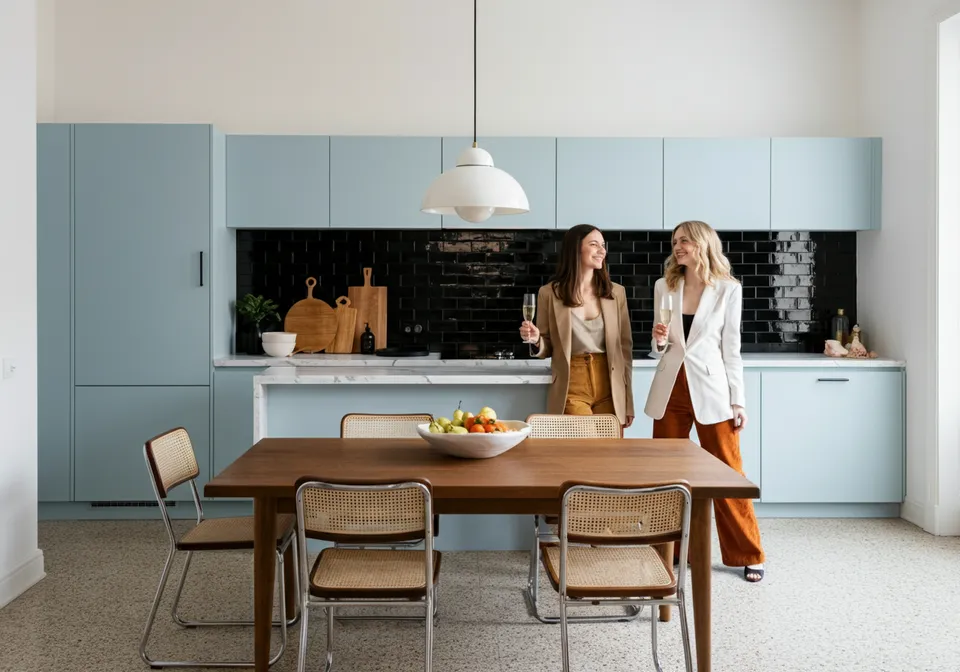
When Should Interior Designers Schedule Professional Photography?
You’ve spent months (maybe years) bringing a project to life, and now it’s time to get it professionally photographed. But when is the right time?
Some designers photograph at install, capturing the space when it’s pristine and untouched. Others wait a few weeks or months, allowing clients to settle in and add final details. But waiting comes with challenges—client clutter, seasonal decor, and the awkwardness of asking to move their personal belongings.
One designer in our community put it bluntly:
“We’ve always done photography later, but it’s starting to feel awkward going back after the client has moved in. I’d love to hear why others choose the timing they do.”
So, what’s the best approach? Let’s break down the pros and cons of photographing at install vs. waiting, and how to make the process seamless for both you and your clients.
Why Many Designers Shoot at Install
For most designers, photographing at install is the gold standard. The space is freshly styled, clients haven’t had time to rearrange furniture, and you don’t have to navigate their personal clutter.
“Always at install. We even have it in our contract that that’s when we do it. It’s beyond awkward to go back, plus you’re taking down kids’ drawings and putting away Christmas decorations.” — hothausinteriors
The Benefits of Shooting at Install
✔ Pristine Condition – No clutter, no lived-in wear, no random Amazon packages in the background.
✔ Design Integrity Maintained – Clients haven’t had time to “tweak” your work with extra accessories that don’t fit the vision.
✔ Less Hassle – You don’t have to coordinate a return visit, which can be a logistical nightmare.
But it’s not always possible. Backordered furniture, artwork that hasn’t arrived, or last-minute contractor touch-ups can make waiting a better option in some cases.
The Case for Waiting: When It Makes Sense
Some designers prefer to schedule a shoot a few weeks later, ensuring every detail is in place.
“Usually, as soon as the last piece is installed. I’ve made the mistake of trying to do the shoot with one thing missing, and then I’m really sorry I did.” — serenityhomestyling
Why Some Designers Wait
✔ Final Details Arrive – That backordered custom rug? The finishing touches on the millwork? Everything is there.
✔ Better Client Experience – If the project involved a long renovation, clients may appreciate time to settle before you return.
✔ Full Styling Control – You can assess the space and adjust anything that doesn’t look right for the shoot.
The downside? Clients have moved in. And that often means:
✖ Clutter & Personalization – Mail piles up, furniture gets rearranged, and suddenly there’s a Keurig on the marble island.
✖ Scheduling Headaches – You’re working around their calendar now, not just yours.
✖ Emotional Attachments – Asking to move personal items (or temporarily remove them) can feel awkward.
“We always go back a week or two later. Installs usually end late, so a same-day shoot doesn’t work for me. Yes, we move things around and put things away, but it’s worth it to capture the perfect shots.” — everyday_elegance_interiors
How to Make Photography Day Stress-Free
Regardless of when you shoot, preparation is everything. Here’s how to make the process smooth:
1. Include Photography in Your Contract
Make it clear from the start that professional photography is part of the process.
💬 What to Say to Clients:
“As part of our design process, we schedule professional photography to document the completed project. This will take place at install or within two weeks of project completion, with minimal disruption to your home.”
2. Style & Prep the Space Like a Magazine Shoot
A professionally styled home photographs very differently than a casually lived-in one.
📌 Pro Tips:
✔ Schedule a professional cleaning before the shoot.
✔ Bring in fresh flowers, greenery, and styling props for a polished look.
✔ Have a steamer, dust cloths, and lint roller for last-minute touch-ups.
✔ If necessary, hire a stylist to fine-tune the space.
3. Make It Easy for the Client
If you have to return later, offer a client perk to make it feel like a value-add rather than an inconvenience.
“If we have to do photos later, we offer a free family photo session. Our photographer schedules it with a network partner, so the client gets a special experience out of it.” — chadofall_chadillac
This sweetens the deal and makes clients more open to the process.
4. Know When to Skip Photography Altogether
Not every project needs to be photographed. If a client isn’t on board, don’t force it.
✔ NDAs in place? Respect the agreement.
✔ Project doesn’t align with your brand? Skip it.
✔ Client resistant? Some will simply never agree—let it go.
The Best Photography Timing for Interior Designers
The best time to schedule photography depends on the project, the client, and your process.
Best-Case Scenario: At Install
- Home is professionally cleaned before the shoot.
- Everything is staged and untouched.
- Photographer and stylist work together to capture the space in its purest form.
Alternative: 1–2 Weeks Later
- Final touches have arrived (art, accessories, etc.).
- Clients are aware that their home needs to be photo-ready.
- You control the environment, moving personal items as needed.
Last Resort: Months Later
- If waiting is unavoidable, offer a client perk like a family photo session.
- Ensure clear communication so they understand why styling adjustments will be made.
Final Takeaways: When Should You Photograph Your Projects?
✔ Photograph at install whenever possible—it’s the best way to capture your design at its peak.
✔ If waiting, set expectations early and offer a smooth, professional experience.
✔ Prep the space like a magazine shoot—clean, styled, and free of distractions.
✔ Not every project needs to be photographed—be strategic about what makes it into your portfolio.
Your portfolio is your most valuable marketing tool—make sure every project is photographed beautifully, professionally, and at the right time.
When do you schedule your interior design project photography? Drop a comment and share your process!



